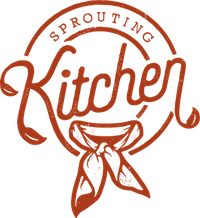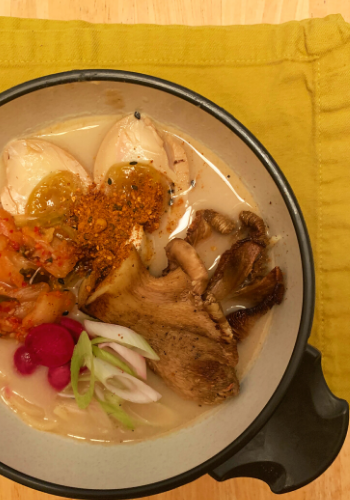Miso piñon ramen
Ramen is a Japanese broth noodle soup, that actually originated from China! It became popular in the US, in the form of “instant ramen” – dried noodles with flavor packets, as I’m sure we all have had them before. In more recent years, a less instant version of ramen has become popular in the US. The kind with deeply flavorful broths, chewy noodles, and lots of fun toppings.
The key is in the broth!
The key to ramen is to have a really good broth, it’s the foundation for the flavor and mouthfeel. If you want to try making bone broth, we’ve got a video here! You can also buy broth at any grocery store, but try to find a quality broth. You can use any type of broth – beef, pork, chicken, vegetable – just know that flavor will be your foundation.
To add some more depth to our broth, we add roasted garlic – if you’ve never roasted garlic before, this may just change your whole life. We’ll blend the garlic with some piñon nuts, which adds toasty, creamy thickness to the broth. Lastly, we’ll add miso paste, which is a creamy paste of fermented soy beans. Miso adds a depth of umami and a hint of sweetness. So, combine the broth, roasted garlic, toasted piñons, and miso – you’re looking at a pretty tasty broth.
When we make our bone broth, we add kombu, which is a common ingredient is ramen, and other Japanese dishes. If you’d like to read more about using kombu to make what is called a dashi broth, check out this blog post from Just One Cookbook.
Our version adds roasted piñons and garlic, which adds creaminess and depth to the ramen. And the miso adds saltiness with a hint of sweetness. This ramen used some traditional Japanese flavors but also brings in a New Mexican twist with the pine nuts.
Another important aspect of ramen are the topping! You’ve got lots of options here. I always love to add a soft boiled egg, kimchi, seared mushrooms, and green onions (all pictured above).
Miso piñon ramen
Ingredients
- 5 cups broth Can use beef, pork, chicken (a mix) or vegetable broth. A high quality broth does make a significant difference here! Use store-bought or make your own homemade broth! (see recipe above)
- 2 heads of garlic
- 1 tablespoon oil
- ¼ cup piñon (pine) nuts
- 2 tablespoosn miso paste
For Serving:
- Ramen noodles or rice noodles
- Soy-marinated soft-boiled eggs (see recipe above)
- Sliced radishes
- Steamed bok choy, carrots, or turnips
- Sliced scallions
- Seared mushrooms
- Kimchi
- Sesame seeds, furikake, or togorashi powder
- Chili oil or hot sauce
- Drizzle of toasted sesame oil
- Any other veggies or toppings you'd like!
Instructions
- Preheat your oven to 400 degrees. Remove the outer skins of the garlic, but keep the bulb intact. Cut about 1/2 inch off the top of the garlic heads, so the cloves are exposed. Place on a baking sheet, drizzle some oil on the exposed garlic cloves, and then wrap in foil, parchment paper, or a container with a lid. Place in the oven and roast for about 40 minutes. Check the garlic, the cloves should look a light golden color and be soft. Cook them in 10 minutes intervals if they need more time. Then let garlic cool and then remove the cloves from the skin.
- Toast piñon nuts on a skillet on medium-low heat, stirring them constantly, until they are light golden in color and fragrant. You can also pop them in the oven at 400 for about 5 minutes until lightly golden – keep an eye on them, as they can burn easily!
- In a blender, add the garlic cloves, piñon nuts, and 1 cup of water. Blend on high until mixture is smooth.
- Warm the broth in medium pot. Add the blender contents and stir. While the broth is warm, but not boiling, scoop out about 1/2 cup of hot broth and mix it with the miso paste, until dissolved. Add the miso liquid into the broth and stir. Taste to see if you need more miso.
- Cook noodles according to package directions.
- To serve place noodles in a bowl. Pour broth over the noodles. Top with desired garnishes and enjoy!
Did you make this recipe?
Tag @thesproutingkitchen on Instagram and hashtag #thesproutingkitchen OR send us an email with your recipe photo and feedback!

